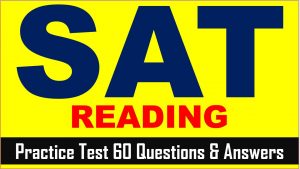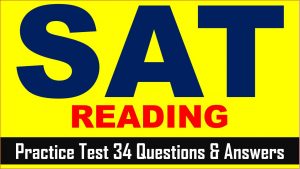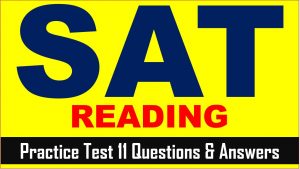Hi SAT Aspirants, welcome to AKVTutorials. As you know SAT (Scholastic Assessment Test) is a standard test, used for taking admission to undergraduate programs of universities or colleges of United States. SAT is developed and published by the College Board, an organization in United States, administered by the Educational Testing Service. Are you searching for SAT Reading Practice Questions? Then, in this article of AKVTutorials, you will get SAT Reading Prep Test 57 | SAT Reading Comprehension Practice Test 65 | SAT 2024 Online Tutor AMBiPi.
SAT Reading Practice Passage
SAT Reading Practice Test Comprehensive Passage
This passage is adapted from a 1932 philosophical essay on the theory of learning and knowledge. The following 10 multiple choice questions are based on the passage below.
| In defining knowledge, there are two further matters to be | |
| taken into consideration, namely the degree of certainty and | |
| the degree of precision. All knowledge is more or less | |
| uncertain and more or less vague. These are, in a sense, | |
| Line 5 | opposing characters: vague knowledge has more likelihood |
| of truth than precise knowledge, but is less useful. One of the | |
| aims of science is to increase precision without diminishing | |
| certainty. But we cannot confine the word “knowledge” to | |
| what has the highest degree of both these qualities; we must | |
| Line 10 | include some propositions that are rather vague and some |
| that are only rather probable. It is important, however, to | |
| indicate vagueness and uncertainty where they are present, | |
| and, if possible, to estimate their degree. Where this can be | |
| done precisely, it becomes “probable error” and “probability”. | |
| Line 15 | But in most cases precision in this respect is impossible. |
| In advanced scientific knowledge, the distinction between | |
| what is a datum and what is inferred is clear in fact, though | |
| sometimes difficult in theory. In astronomy, for instance, the | |
| data are mainly certain black and white patterns on | |
| Line 20 | photographic plates. These are called photographs of this or |
| that part of the heavens, but of course much inference is | |
| involved in using them to give knowledge about stars or | |
| planets. Broadly speaking, quite different methods and a | |
| quite different type of skill are required for the observations | |
| Line 25 | which provide the data in a quantitative science, and for the |
| deductions by which the data are shown to support this or | |
| that theory. There would be no reason to expect Einstein to | |
| be particularly good at photographing the stars near the sun | |
| during an eclipse. But although the distinction is practically | |
| Line 30 | obvious in such cases, it is far less so when we come to less |
| exact knowledge. It may be said that the separation into data | |
| and inferences belongs to a well-developed stage of | |
| knowledge, and is absent in its beginnings. | |
| But just as we found it necessary to admit that knowledge | |
| Line 35 | may be only a characteristic of behavior, so we shall have to |
| say about inference. What a logician recognizes as inference | |
| is a refined operation, belonging to a high degree of | |
| intellectual development; but there is another kind of | |
| inference which is practiced even by animals. We must | |
| Line 40 | consider this primitive form of inference before we can |
| become clear as to what we mean by “data”. | |
| When a dog hears the gong and immediately goes into the | |
| dining-room, he is obviously, in a sense, practicing inference. | |
| That is to say, his response is appropriate, not to the noise of | |
| Line 45 | the gong in itself, but to that of which the noise is a sign: his |
| reaction is essentially similar to our reactions to words. An | |
| animal has the characteristic that, when two stimuli have | |
| been experienced together, one tends to call out the response | |
| which only the other could formerly call out. If the stimuli | |
| Line 50 | (or one of them) are emotionally powerful, one joint |
| experience may be enough, if not, many joint experiences | |
| may be required. This characteristic is totally absent in | |
| machines. Suppose, for instance, that you went every day for | |
| a year to a certain automatic machine, and lit a match in front | |
| Line 55 | of it at the same moment at which you inserted a penny, it |
| would not, at the end, have any tendency to give up its | |
| chocolate on the mere sight of a burning match. That is to say, | |
| machines do not display inference even in the form in which | |
| it is a mere characteristic of behavior. Explicit inference, | |
| Line 60 | such as human beings practice, is a rationalizing of the |
| behavior which we share with the animals. Having | |
| behavior which we share with the animals. Having | |
| as we originally reacted to B. To make this seem rational, we | |
| say that A is a “sign” of B, and that B must really be present | |
| Line 65 | though out of sight. This is the principle of induction, upon |
| which almost all science is based. And a great deal of | |
| philosophy is an attempt to make the principle seem | |
| reasonable | |
| Whenever, owing to past experience, we react to A in | |
| Line 70 | the manner in which we originally reacted to B, we may say that |
| A is a “datum” and B is “Inferred”. In this sense, animals | |
| practice inference. It is clear, also, that much inference of this | |
| sort is fallacious: the conjunction of A and B in past | |
| experience may have been accidental. What is less clear is | |
| Line 75 | that there is any way of refining this type of inference which |
| will make it valid. That, however, is a question which we | |
| shall consider later. What I want consider now is the nature | |
| of those elements in our experiences which, to a reflective | |
| analysis, appear as “data” in the above-defined sense. |
SAT Reading Comprehension Practice Test Questions
SAT Reading Practice Test Question No 1
Which choice best characterizes the “knowledge” discussed in the first paragraph?
Option A : Dichotomy.
Option B : Contradiction.
Option C : Paradox.
Option D : Coexistence.
SAT Practice Test Answer No 1
Show/Hide Answer
Option C : Paradox.
SAT Reading Practice Test Question No 2
The primary purpose of the article is to
Option A : provide a preliminary discussion to define datum and inference.
Option B : lay the groundwork for refinement of inference types to make them logically sound.
Option C : conclude with authority how inference from objects can be made from separation of datum.
Option D : identify the necessary conditions and premises for a projected conclusion soon to be made.
SAT Practice Test Answer No 2
Show/Hide Answer
Option A : provide a preliminary discussion to define datum and inference.
SAT Reading Practice Test Question No 3
The author suggests that “we cannot confine the word knowledge” with certainty and precision because
Option A : certainty can not itself guarantee precision.
Option B : precision under most circumstances is impossible.
Option C : vagueness can not be indicated with any degree of certainty.
Option D : knowledge seldom possesses the two qualities.
SAT Practice Test Answer No 3
Show/Hide Answer
Option A : certainty can not itself guarantee precision.
SAT Reading Practice Test Question No 4
The author uses the quotations in line 14 primarily in order to
Option A : present an negative attitude.
Option B : define particular concepts.
Option C : emphasize specific feelings.
Option D : provide different understandings.
SAT Practice Test Answer No 4
Show/Hide Answer
Option B : define particular concepts.
SAT Reading Practice Test Question No 5
The example of astronomy presented in lines 18-23 serves best to
Option A : confirm that the photograph presents reality that can be measured with high degree of certainty.
Option B : highlight the primary quality of datum as the factual basis for further deliberation.
Option C : explain why black and white evidences add strength to the ensuing inference.
Option D : introduce the field of quantitative science with its rigorous requirements of precision.
SAT Practice Test Answer No 5
Show/Hide Answer
Option B : highlight the primary quality of datum as the factual basis for further deliberation.
SAT Reading Practice Test Question No 6
The “distinction” in line 29 primarily indicates that
Option A : Einstein has no applicable skill in photo-taking or any related field.
Option B : scientists have no need to delve into particular set of data for conclusion.
Option C : inference making shall be treated differently from obtaining data.
Option D : exact knowledge does not separate induction from inference.
SAT Practice Test Answer No 6
Show/Hide Answer
Option C : inference making shall be treated differently from obtaining data.
SAT Reading Practice Test Question No 7
What is the function of the third paragraph in an overview of the article?
Option A : It introduces to readers a brand-new concept.
Option B : It shifts the discussion focus to another discipline.
Option C : It qualifies to the primary argument.
Option D : It directs reader attentions to another aspect of the argument.
SAT Practice Test Answer No 7
Show/Hide Answer
Option D : It directs reader attentions to another aspect of the argument.
SAT Reading Practice Test Question No 8
The “dog” in line 42 clearly does which of the following?
Option A : It responds to signs.
Option B : It performs an inference.
Option C : It ignores the noise.
Option D : It attends to the instrument.
SAT Practice Test Answer No 8
Show/Hide Answer
Option B : It performs an inference.
SAT Reading Practice Test Question No 9
Which choice best illustrates the circumstance where “many joint experiences” may NOT be required?
Option A : A person moves his hands along with legs when walking.
Option B : A train blows horn when making an entrance to platform.
Option C :A song is played with both violin and piano in orchestra.
Option D : A building has its only front door decorated with flowers.
SAT Practice Test Answer No 9
Show/Hide Answer
Option B : A train blows horn when making an entrance to platform.
SAT Reading Practice Test Question No 10
Which generalization about the Vikings is supported by both passages?
Option A : Devoted to warfare, the Vikings built an empire that reshaped the map of Europe.
Option B : Innovations in shipbuilding and navigation saved the Vikings from decline and extinction.
Option C : The Vikings were noble warriors and farmers who sought to better understand the world.
Option D : Through their seafaring skills and abilities, the Vikings expanded and changed the world.
SAT Practice Test Answer No 10
Show/Hide Answer
Option A : Devoted to warfare, the Vikings built an empire that reshaped the map of Europe.
SAT Reading Practice Test Question No 11
Which inference from the two passages is supported by the information in the timeline on page 100?
Option A : The Vikings endeavored to relocate surplus population through colonization.
Option B : The Vikings hoped to expand their cultural influence through economic exchange.
Option C : The Vikings traveled far and wide to launch sea raids and conduct trade.
Option D : The Vikings were compelled to abandon their homelands because of scarcity.
SAT Practice Test Answer No 11
Show/Hide Answer
Option B : The Vikings hoped to expand their cultural influence through economic exchange.



